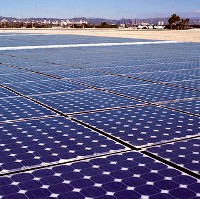An environmental engineer at University of California San Diego (UCSD) has researched the optimum placement of fixed solar panels in the U.S., and for some installations, it may mean making adjustments. UCSD environmental engineering professor Jan Kleissl computed the optimum tilt and azimuth angles for photovoltaic solar panels in the continental U.S., with his findings published recently in the journal Renewable Energy (paid subscription required).
Kleissl and graduate student Matt Lave discovered that for many current and potential solar sites, the rule-of-thumb practice of facing solar panels due south may not generate the most electrical power. The position of the building relative to the sun should dictate the tilt and azimuth of the panels, but using the National Solar Radiation Database, they found standard practices to vary from the optimum configuration by up to 10 percent. The greatest variations occur in coastal areas, Florida, Texas, New Mexico, and Colorado.
Kleissl and Lave now offer their findings for California’s solar panel owners, installers, and utilities in a map that estimates the energy they can expect from their solar power systems. “Probably the most important result of this work for California is that in all coastal areas (Los Angeles, San Francisco, San Diego) it is advantageous to install the panels facing about 10-degrees west of south,” Kleissl says.
Kleissl adds that panels facing southwest “see” the sun longer and at a better angle than panels facing south, which means that the energy generated is larger during the peak demand hours (3:00 to 5:00 p.m.), making the energy more valuable.
* * *


 RSS - Posts
RSS - Posts
You must be logged in to post a comment.